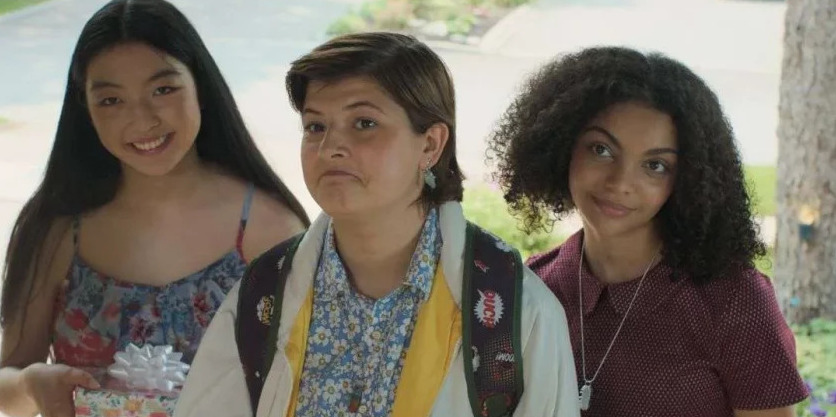The FilmSoc Journal is back for the 30th edition of the Raindance Film Festival, the largest independent film festival in the UK.
Elena Goh reviews Julianna Notten’s queer teen rom-com Erin’s Guide to Kissing Girls, a jubilant debut that explores the less-traversed aspects of queerness and fandom.
Teen school dramas are admittedly my guilty pleasure. It doesn’t matter how trashy they are, it’s always fun to laugh at the characters, witness their struggles, and watch their 3-minute YouTube clips at 1.30 AM while you’re procrastinating an essay.
The fact that you can guess the whole plot from the trailer doesn’t make a difference. In fact, part of the comforting charm of school dramas lies in their predictability — you can always rely on them to recycle the same tropes, to the point where characters feel less like individuals and more like representations of archetypes. Unfortunately, this predictability also applies to the characters’ social backgrounds. As teen dramas are mostly entrenched within popular culture and restrained by their profit-driven motives, most of them focus on heteronormative stories of white, middle-class Americans experiencing things assumed to be as universal as they are uncontroversial. While the appeal of these films remains for people outside this mold, they take on a pseudo-fantastical nature. These stories are so removed from anything in the audience’s reality that they resemble escapism more than relatability.
This is where Erin’s Guide to Kissing Girls comes in. Directed by Julianna Notten, her debut feature film is a coming-of-age tween queer rom-com following Erin (Elliot Stocking) and how she deals with friendship and first love. Best friends Erin and Liz (Jesyca Gu) are comic book nerds who spend their days drawing fanart for the Lunagirl & Scarlet Sparrow series, but things become complicated when Erin develops a crush on the new popular girl and ex-child star, Sydni (Rosalie Annikie). Erin concocts an elaborate plan to, as the title suggests, ask Sydni to the school dance and kiss her, but it goes awry as her friendship with Liz begins to crumble, forcing Erin to embark on a tumultuous journey of self-discovery.
As Notten introduced at the start of the film, Erin’s Guide to Kissing Girls was conceived as a ray of light-hearted sweetness to get through dark times, and the film is indeed very fun to watch. While it retains the colourful theatricality of Love, Simon, it bears greater resemblance to Netflix’s Heartstopper with its sincerity and loving familiarity with queer culture, especially in its understanding of the relationship between fandom and queer youth. The film is still centred around the American middle-school experience, but I was surprised by how much I could relate to its characters and their friendships, especially in their dry humour and nerdy silliness. Nonetheless, what makes Erin’s Guide to Kissing Girls unique is its ability to look beyond the more performative aspects of queer culture and capture a quality that is deeper and more intangible — the messy intersection between friendship and romance that often occurs in queer relationships, and how it plays out at an age where your self-identity is a confused, blurry thing.
While it depicts the usual emotional turmoil of adolescence, the film does never sensationalises Erin’s sexuality, as is common in LGBTQ teen dramas. As per Notten’s desire to create a film with positive coming-of-age queer representation, Erin experiences no dramatic coming-out or tragic backstory. Discrimination does occur, but her insecurity stems from being an awkward dork, and that makes her far more endearing and authentic as a representation of queer youth. There’s also an interesting touch of intersectionality in the portrayal of Liz. Far from being a POC sidekick, Gu steals the spotlight in every scene she appears in, deftly presenting Liz as both an overachiever and a snarky, queer geek who is just as chaotic as Erin. The production team’s familiarity with teen queer culture is evident in all of the film’s loving details — Erin’s quirky earrings, her bedroom posters, and the shot of Sydni reading Orlando during lunch. There’s a personal touch to everything, so it wasn’t surprising when Notten mentioned in the Q&A that the story was inspired by her own 8th-grade diary, or that Erin’s outfits came directly out of her actress’s closet. Like Heartstopper, everything from the socks to the choice of music feels recognizably queer. In its playful dramatisation of high-school tropes — cue the Mean Girl Trio walking in slow-motion, outfits colour-coordinated à la Powerpuff Girls — it retains the theatrical, trope-heavy fun of Love, Simon with half the budget and twice the sincerity. It is less of a High School Musical dance number to Whitney Houston, and more doodling your crush as a magic sci-fi moon princess.
But Erin’s Guide to Kissing Girls explores something neither Love, Simon nor Heartstopper were quite able to capture — the messy, unclear intersection between friendship and romance that often occurs between queer teens, especially queer girls, described by Notten as an “intense friendship” during the Q&A. Perhaps because the characters are much younger than in the other two shows, there seems to be less pressure on the film to have an established couple by the ending, and more space for exploring ambiguous, complex relationships. It is in their emotional uncertainty that a kind of precious innocence blooms, and the nuance with which the film portrays it is incredibly impressive. The connection between the characters is as profound as it is playful, forged by both emotional intimacy and creating dumb cosplay outfits together-resultantly, it is a critical part of the formation of their identities. Rendering the title somewhat ironic, what’s important isn’t whether the characters become romantically involved, but the fact that these relationships allow them to gain empathy and a clearer understanding of themselves. It’s a kind of homosocial relationship that I believe is characteristic of queer youth, but one that is explored less often because of how difficult it is to capture- and yet, Erin’s Guide to Kissing Girls does, with humour and sensitivity. It reminded me of the stories of my friends and the queer-coded friendships I experienced in high school, and as a whole, it was a welcome surprise in what I expected to be just another American teen drama.
On the subject of relatability, another aspect that I enjoyed was the presentation of the relationship between fandom, teenage identity formation, and queerness. As comic book fans, superheroes are to Erin and Liz a means of escapism and a way to process reality. While they take comfort in the colourful safety of fantasy, the film reflects on how Erin uses fan comics to reflect on her experiences as they happen, projecting her feelings onto the characters, and through them understands her life as an ongoing narrative. Through Erin’s doodles and colourful animation, the film eloquently showcases why fandoms are appealing to so many teenagers, especially queer youth. The film pokes fun at the silliness of nerd culture, but it also showcases how fantasy provides a safe space for youth to project themselves onto what feels like an impossible deluge of identities and possibilities. This is evident in the underlying queerness of the film’s comic books — the appearances of Lunargirl and the Scarlet Sparrow are decidedly gender-ambiguous, and it is because of the events in the comic book that the characters are forced to confront their feelings.
As a whole, Erin’s Guide to Kissing Girls is a win for LGBTQ teen representation and a fun, feel-good movie. It’s really cute, so go watch it.




